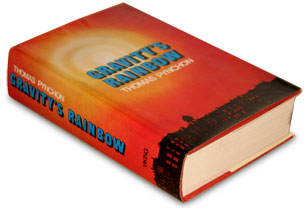Difference between revisions of "Gravity's Rainbow"
| Line 1: | Line 1: | ||
[[File:Book_GR_sm.jpg|350px|thumb|''Gravity's Rainbow''<br />'''Jacket Art:''' [[Marc_Getter_-_Designer_and_Artist|Marc Getter]]<br />'''Publication date:''' Feb 28, 1973|right]] | [[File:Book_GR_sm.jpg|350px|thumb|''Gravity's Rainbow''<br />'''Jacket Art:''' [[Marc_Getter_-_Designer_and_Artist|Marc Getter]]<br />'''Publication date:''' Feb 28, 1973|right]] | ||
| − | + | ==Cover Art== | |
| − | + | '''NOTE:''' You can view the many variations of ''Gravity's Rainbow'' cover art through the years at [http://thomaspynchon.com/pynchon-cover-art/the-crying-of-lot-49/ ThomasPynchon.com] | |
| − | + | ||
| − | + | ||
| − | + | ||
| − | + | ||
| − | + | ||
:Nathaniel Hawthorne publishes The House of the Seven Gables. Rev. Thomas Ruggles Pynchon (1823-1904) writes the author a letter, complaining about the 'abuse' of the 'Pyncheon' name. This rev. Thomas Ruggles Pynchon will become the ninth president of Trinity College in Hartford, Conn, where he teaches science and religion. In 1881 he publishes an Introduction to Chemical Physics. His brother William is the great-grandfather of author Thomas Pynchon. | :Nathaniel Hawthorne publishes The House of the Seven Gables. Rev. Thomas Ruggles Pynchon (1823-1904) writes the author a letter, complaining about the 'abuse' of the 'Pyncheon' name. This rev. Thomas Ruggles Pynchon will become the ninth president of Trinity College in Hartford, Conn, where he teaches science and religion. In 1881 he publishes an Introduction to Chemical Physics. His brother William is the great-grandfather of author Thomas Pynchon. | ||
Revision as of 07:37, 12 September 2014
Cover Art
NOTE: You can view the many variations of Gravity's Rainbow cover art through the years at ThomasPynchon.com
- Nathaniel Hawthorne publishes The House of the Seven Gables. Rev. Thomas Ruggles Pynchon (1823-1904) writes the author a letter, complaining about the 'abuse' of the 'Pyncheon' name. This rev. Thomas Ruggles Pynchon will become the ninth president of Trinity College in Hartford, Conn, where he teaches science and religion. In 1881 he publishes an Introduction to Chemical Physics. His brother William is the great-grandfather of author Thomas Pynchon.
The use of language in his 'Introduction to Chemical Physics is reminiscent of his younger namesake:
- "The name Chemistry, is said to be derived from the Arabic word Kimia, something hidden or concealed, and from this, to have been converted into Xyueia*, a word first used by the Greeks about the eleventh century, and meaning the art of making gold and silver. Between the fifth century and the taking of Constantinople in the fifteenth century, says Dr. Thomson, in his History of Chemistry, the Greeks believed in the possibility of making god and silver artificially; and the art which professed to teach the processes was called by them, Chemistry. This idea, however, has long since been thoroughly discarded, and is now no longer heard of."
Like the author we are discussing, The Thomas Pynchon of Trinity College, Hartford Connecticut, was a daunting polymath. If you open 'Introduction to Chemical Physics', one of the first things you will see is are Rainbows, the rainbows from the workings of a Chemical Spectrometer:
- When a material is heated to incandescence it emits light that is characteristic of the atomic makeup of the material. Particular light frequencies give rise to sharply defined bands on the scale which can be thought of as fingerprints. For example, the element sodium has a very characteristic double yellow band known as the Sodium D-lines at 588.9950 and 589.5924 nanometers, the colour of which will be familiar to anyone who has seen a low pressure sodium vapor lamp.
One of the branches of the Pynchon Clan, George M. Pynchon, ran the Wall Street Investment firm Pynchon & Company. Pynchon & Company started up with Real Estate and Railroads, got involved in all sorts of [then] high-tech enterprises like gas and electrical grids, the work of Thomas Alva Edison including Edison/GE's Mazda Lamp Division, with the firm's director George M. Pynchon enjoying a public life as a champion Yacht Racer. Pynchon & Company fell apart in 1931 when film maker and investor William Fox was taken down by a consortium of Banking and Technology interests, including Western Electric, RCA and a number of very large banks. Some of those very large banks infamously invested in the emerging new economy of a re-industrialized Germany, under the bold direction of its new leader, Adolph Hitler. In particular, I. G. Farben became a cash nexus for a number of American Investors whose view never went any farther than the bottom line. Much of the scientific material in Gravity's Rainbow concerns the commercial applications of Chemistry.
In Gravity's Rainbow, 'we' start in a train:
- "There are no lights inside the cars."
- . . . .and wind up in a theater, waiting for the end to come, singing an old church hymn from Tyrone Slothrop's Pig Farming Ancestor, William Slothrop:
- And it is just here, just at this dark and silent frame, that the pointed tip of the Rocket, falling nearly a mile a second, absolutely and forever without sound, reaches its last unmeasurable gap above the roof of this old theatre, the last delta-t.
- There is time, if you need the comfort, to touch the person next to you, or to reach between your own cold legs . . . or, if song must find you, here's one They never taught anyone to sing, a hymn by William Slothrop, centuries for gotten and out of print, sung to a simple and pleasant air of the period. Follow the bouncing ball:
There is a Hand to turn the time,
Though thy Glass today be run,
Till the Light that hath brought the Towers low
Find the last poor Pret'rite one . . .
Till the Riders sleep by ev'ry road,
All through our crippled Zone.
With a face on ev'ry mountainside,
And a Soul in ev'ry stone. . . .
- Now everybody---
More to come,
Robin Landseadel
